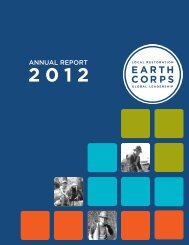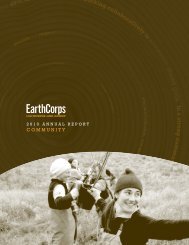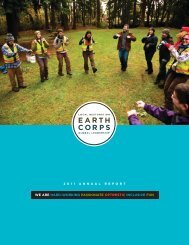Invasive and Native Trees of the Pacific Northwest - EarthCorps
Invasive and Native Trees of the Pacific Northwest - EarthCorps
Invasive and Native Trees of the Pacific Northwest - EarthCorps
Create successful ePaper yourself
Turn your PDF publications into a flip-book with our unique Google optimized e-Paper software.
<strong>Invasive</strong> <strong>Trees</strong> Found in <strong>the</strong> Puget Sound Region<br />
<strong>EarthCorps</strong> is a Seattle-based nonpr<strong>of</strong>it organization dedicated to building global<br />
community through local environmental service. <strong>EarthCorps</strong> trains young adults ages<br />
18-25 <strong>and</strong> leads more than 11,000 volunteers, providing 100,000 hours <strong>of</strong> service<br />
annually. Projects include restoring urban forests, salmon habitat, shoreline, riparian<br />
areas <strong>and</strong> wetl<strong>and</strong>, <strong>and</strong> building <strong>and</strong> maintaining trails.<br />
Cherry laurel (Prunus laurocerasus) is<br />
an evergreen tree <strong>and</strong> is among <strong>the</strong> most<br />
prevalent invasive species in Seattle’s<br />
parks <strong>and</strong> open spaces. This popular<br />
garden species grows <strong>and</strong> reproduces in<br />
<strong>the</strong> forest environment, <strong>and</strong> competes<br />
with native species. The seeds are<br />
dispersed by birds who eat <strong>the</strong> berries.<br />
Portugal laurel (Prunus lusitanica), an<br />
evergreen invasive tree, is <strong>of</strong>ten<br />
overlooked as a threat to our urban<br />
forests. This plant is able to reproduce in<br />
<strong>the</strong> forest understory in low light<br />
conditions. It competes with <strong>and</strong><br />
displaces native species when<br />
established. It is spread by birds who<br />
eat <strong>the</strong> berries.<br />
European mountain ash (Sorbus<br />
aucuparia) is a deciduous horticultural<br />
tree with clusters <strong>of</strong> orange-red berries<br />
that attract birds. This tree is frequently<br />
found in our urban forests, courtesy <strong>of</strong><br />
birds dropping seeds.<br />
Cherry laurel<br />
English holly (Ilex aquifolium)<br />
is ano<strong>the</strong>r invasive evergreen plant<br />
dispersed by birds. This traditional<br />
l<strong>and</strong>scape plant is one <strong>of</strong> <strong>the</strong> most<br />
common invasive species found in<br />
Seattle’s urban forests <strong>and</strong> can be<br />
spread from miles away.<br />
Portugal laurel<br />
Horse chestnut (Aesculus<br />
hippocastanum) is ano<strong>the</strong>r commonly<br />
planted European horticultural plant.<br />
This deciduous tree has five-lobed<br />
leaves <strong>and</strong> attractive flowers. The nuts<br />
are spread to natural areas by birds <strong>and</strong><br />
animals. Once established, it competes<br />
with native vegetation for space, light<br />
<strong>and</strong> nutrients.<br />
European mountain ash<br />
European hawthorn or one-seed<br />
hawthorn (Crataegus monogyna) is a<br />
deciduous tree which is capable <strong>of</strong><br />
reproducing in forest conditions. It is a<br />
common invasive species found in<br />
Seattle’s forests <strong>and</strong> <strong>of</strong>ten creates dense<br />
thickets in disturbed areas. It is spread<br />
by birds who eat <strong>the</strong> clusters <strong>of</strong> red<br />
berries produced in <strong>the</strong> fall. European<br />
hawthorn is a popular horticultural plant.<br />
Photos courtesy <strong>of</strong> Nelson Salisbury<br />
English holly<br />
Horse chestnut<br />
European hawthorn<br />
To support <strong>EarthCorps</strong> or for more information, please visit www.earthcorps.org
<strong>Native</strong> <strong>Trees</strong> for L<strong>and</strong>scaping<br />
<strong>EarthCorps</strong> is a Seattle-based nonpr<strong>of</strong>it organization dedicated to building global<br />
community through local environmental service. <strong>EarthCorps</strong> trains young adults ages<br />
18-25 <strong>and</strong> leads more than 11,000 volunteers, providing 100,000 hours <strong>of</strong> service<br />
annually. Projects include restoring urban forests, salmon habitat, shoreline, riparian<br />
areas <strong>and</strong> wetl<strong>and</strong>, <strong>and</strong> building <strong>and</strong> maintaining trails.<br />
Western red cedar (Thuja<br />
plicata) is a beautiful evergreen<br />
conifer tree that can grow up to<br />
200 feet tall. It is usually found in moist<br />
soils <strong>and</strong> tends to prefer <strong>the</strong> shade. This<br />
tree is an important part <strong>of</strong> <strong>the</strong> culture <strong>of</strong><br />
<strong>the</strong> <strong>Native</strong> Americans in this region, <strong>and</strong><br />
is held in <strong>the</strong> highest regard for its<br />
healing <strong>and</strong> spiritual powers.<br />
Bitter cherry (Prunus emarginata)<br />
is a small tree that can reach a<br />
height <strong>of</strong> about 45 feet. It<br />
produces white to pinkish flowers that will<br />
add a splash <strong>of</strong> color to any native plant<br />
garden. Its bright red cherries make this<br />
tree striking, but are quite bitter in flavor.<br />
Bitter cherry can grow in full sun.<br />
Douglas fir (Pseudotsuga<br />
menziesii) is a large evergreen<br />
conifer that can grow over 200<br />
feet tall. It is well-adapted for dry or<br />
moist soil, <strong>and</strong> can grow in full-sun. It<br />
has thick, ridged bark that is rough <strong>and</strong><br />
dark brown. Under natural conditions,<br />
this tree can live over 1000 years!<br />
Western red cedar<br />
<strong>Pacific</strong> madrone (Arbutus<br />
menziesii) is a unique evergreen<br />
tree with shiny green leaves <strong>and</strong><br />
orange-red berries. Its most<br />
distinct feature is <strong>the</strong> orange to brownish<br />
bark that peels <strong>of</strong>f in large strips<br />
revealing smooth green wood. This tree<br />
is found in dry, sunny, <strong>and</strong> well-drained<br />
sites, <strong>and</strong> is <strong>of</strong>ten associated with<br />
Douglas fir trees.<br />
Bitter cherry<br />
Western hemlock (Tsuga<br />
heterophylla) is an elegant<br />
evergreen conifer tree found in<br />
<strong>the</strong> <strong>Pacific</strong> <strong>Northwest</strong>. It has<br />
down sweeping branches, fea<strong>the</strong>ry<br />
needles, <strong>and</strong> reddish-brown bark. It can<br />
grow in moist to wet soils, <strong>and</strong> is<br />
extremely shade-tolerant. With a high<br />
tannin content in <strong>the</strong> bark, <strong>Native</strong><br />
Americans used it as a tanning agent.<br />
Douglas fir<br />
Cascara (Rhamnus<br />
purshiana) is a small tree<br />
that can grow up to 30<br />
feet tall. It has eggshaped<br />
leaves <strong>and</strong> produces blue to<br />
black berries that are edible but not so<br />
tasty. Its silver-gray bark was used as a<br />
strong laxative by <strong>Native</strong> Americans in<br />
<strong>the</strong> region. Cascara can grow in dry to<br />
wet soil, <strong>and</strong> is <strong>of</strong>ten found alongside<br />
vine maples.<br />
Photos courtesy <strong>of</strong> Nelson Salisbury<br />
<strong>Pacific</strong> madrone leaves, berries & bark<br />
Western hemlock<br />
Cascara<br />
To support <strong>EarthCorps</strong> or for more information, please visit www.earthcorps.org





